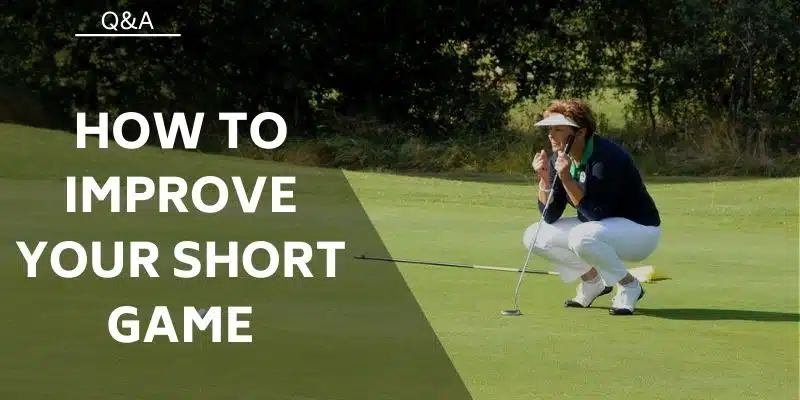You know the adage, ”Drive for show, putt for dough.” Yes, those big booming drives or long irons down the fairway can be very impressive, and putting could count for around half the numbers on your scorecard.
Now, what happens when you find yourself a bit short of the green or with a bunker or pond between you and the flag? Worse still, that sexy drive left the fairway, and you find yourself in the rough amongst the trees with low-hanging branches.
What is the difference between chipping vs pitching? Chipping is ideal near the green when ground conditions are favorable and you want the ball to roll. You’d use a 7 or 9-iron. In contrast, pitching employs wedges to produce a higher arc, allowing the ball to soar over obstacles and land with precision, often utilized when barriers lie between the ball and the green.
But this is just a brief outline. You need much more info for golf chipping vs pitching to perform them well. Don’t worry, though. Read on to learn how to select which is best and know how to perform each technique correctly.
Chipping vs Pitching: Key Differences
The primary difference between chip and pitch shots is that you use each in different scenarios. When to chip vs when to pitch predominantly depends on the ground conditions you face. While both are short-game shots, chips are generally favored when you have a good lie, and there are no obstacles between you and the hole. This allows you to take advantage of the increased control that chipping offers.
Pitching, on the other hand, is your go-to shot when you can’t perform a chip. This is usually because obstacles are in the way. Therefore, you need a shot that spends more time in the air than on the ground.
When it comes to performing chips vs pitches, the main difference relates to your wrist. With the chip shot, you shouldn’t have any wrist hinge, yet you want to engage your wrists for pitches. However, you should avoid engaging your wrists too much, as your body rotation should do most of the work.
As for club selection, the differences between chipping and pitching are large. While pitches exclusively use wedges (or a 9-iron at a push), you have more options for chips. You can still use wedges with chip shots but go as low as a 3-iron.
What Is Chipping in Golf and When to Use
Chip shots are primarily used when you are fairly close to the hole and ground conditions are favorable. Given that the ball will travel mostly along the ground, the bounce needs to be predictable, so avoid using a chip shot if there are obstacles. Similarly, if the hole is some distance away, say more than 50 yards, even if the ground is easy to read, such a great distance increases the likelihood that a small miscalculation will snowball into a sizeable miss.
There are two main situations where the chip shot could be the best option. Firstly if you happen to be in the rough, say under trees, you need to keep the ball low. Here the need is to punch the ball out low and advance as far as possible toward the target.
The second situation is when you are just short of the green, the flag is some distance from the front, and there is a fair distance to run.
How to Chip
There are many factors to remember to hit a chip shot successfully. When aiming your chip shot, you should read the green just as if you were putting, so you might crouch down to check the lie of the land first.
Pick out a marker, say a leaf or blade of grass along the intended line, but closer to the ball and your eye line, as a secondary target. Now you can align the clubface to this target and position your feet.
Club Choice
If you’re coming out of the rough with some distance to the green, you might take a 5 or even a 3-iron. Closer to the green, you want to drop the ball about 3 feet onto the putting surface and allow it to run the rest of the way to the pin.
You, therefore, need to consider the distance to the green and the amount of green you have to work with. A wedge will give you about equal flight and roll, whereas a sand wedge will have less roll. On the other hand, a 7-iron will have much more roll out to reach pin positions further back on larger greens.
Stance
We now have to look at the stance, which will more closely resemble your putting stance than that of the full golf swing. Your feet should be much closer together with the ball positioned further back in the stance, just off the inside of your back foot.
Keep your weight forward, without tilting (around 60-70% of your weight should be on the front foot). This ball position and weight distribution will allow you to hit down on the ball keeping it low and rolling forward.
Grip
When it comes to the grip, some coaches will recommend the standard grip you use for a full swing. Others opt for the putting grip as the stroke will be similar to a putt but with a different club and a bit more force. What is important is to have a “light”, but firm grip to increase the feel. The main quality you want the grip to influence is the face angle at impact.
Swing
Now you are ready to swing and hit your shot. The chipping swing will be similar to a putt, using a pendulum action and not breaking the wrists. This will ensure that the clubface remains square to the target and prevents the ball from flying off at an angle.
The chipping technique for your backswing and the follow-through should be of equal length. Remember to accelerate through the shot, slowing down will result in a huge fluff.
Read More: How to Improve Your Chipping
When to Pitch
The main similarity between chipping and pitching is that both are not full-swing shots. But unlike the chip shot, with the pitch, you are looking for a flight trajectory with little or no roll out.
You would choose a pitch shot if you were faced with an obstruction, such as a pond, stream, or bunker that you need to get over. It may also be that the ground conditions on the way to the green were such that a chip-and-run would not work, or that the hole is simply too far away for a chip.
Pitches work particularly well when the pin is near the edge of the green. This is because the ball stays airborne for longer periods due to the increased backspin, and there is very little roll out.
How to Pitch
The basics remain the same when it comes to aiming the pitch shot compared to a chip, aim the clubface at the target and your feet parallel to that. The pitch shot may be a bit stronger than the chip but is still not a full swing.
Club Choice
To hit a pitch shot you need to use high lofted clubs from a lob wedge to say a 9-iron, depending on the distance and the height required. Again, we must look at aim, grip, stance, and setup to execute a successful pitch shot.
Stance
With the pitch shot, your stance will be more open, feet apart about shoulder width. The ball placement will be in the middle of your stance, and your weight will still favor the front foot.
Placing the ball further forward will give you more height if required. Some coaches differ on whether to hit down on the ball to produce spin, or to hit the ball and ground together. The answer probably lies in the “bounce” of your clubs. Practice will show you where it works best.
Grip
While players are split between full-swing grips and putting grips for chip shots, pitches always use a full-swing grip. This means the V’s of your hands should be facing your rear shoulder. Make sure you don’t grip the club too tightly — you want to keep the club secure without feeling too stiff.
You should also adjust your hand placement depending on the distance you are from the hole. For short-pitch shots, lower your grip and narrow your stance, and for longer pitches, grip higher on the club and widen your stance instead.
Swing
The pitching swing is essentially the same as the chip shot. Ensure the backswing and the follow-through are the same distance and accelerate through the shot.
The main difference in the pitch shot compared to chips is that you will break the wrists and allow them to hinge on the backswing. As always, finish with your weight on the front foot.
While practicing pitches, you should also try to master the flop shot. If possible, you employ the flop when you want the ball to pitch and sit with no roll-out.
To pull off this technique, you will open the clubface more and open your stance further. Make sure that the clubface remains perpendicular to the target at all times.
This video will give you some tips on how to master the pitch shot.
Read More: The Best Pitching Wedges
Closing Thoughts
Hopefully, that clears up the chipping vs pitching debate. While both are short-game strokes, chip shots vs pitch shots excel in different situations and you should incorporate both into your game. Remember, if you want to keep the ball low and bouncing because you don’t have any obstacles to overcome, the chip shot is one you want to consider. Alternatively, if you need to clear some obstacles or if the pin is close to the edge of the green, a pitch shot is a much better choice.
Most of the time, the decision of golf pitching vs chipping is clear as distance, lie, and hazards will clearly point you in one direction. If you find this is not the case, you may need to work on reading the course better.
Frequently Asked Questions
Is It Better to Chip or Pitch?
Neither chipping nor pitching is better, they both excel at different things. Chip shots are better when ground conditions are promising as they are easier to execute. Pitch shots, on the other hand, are superior when obstacles are present. The increased carry time allows you to clear them and land softly on the green.
What Club Do You Use to Chip?
The pitching wedge is the most common club to chip with, however, you can also chip with other wedges and even go down to as low as a 3-iron.
What Club Do You Use to Pitch?
To pitch the golf ball, you need a club with a strong loft. We recommend sticking to wedges. If you go any lower you may struggle to attain the air time you need to clear obstacles.
What Is the Difference Between a Chip vs Pitch vs Flop Shot?
Chips have little carry time and mostly bump and roll along the ground, pitch shots have greater carry time with little roll, and flop shots have the most carry time and minimal roll.
Which Is Easier Chip Shots vs Pitch Shots?
Chip shots are easier to execute as the motion is more straightforward and you play the ball more directly towards the hole.
Which Shot Can You Play From a Further Distance Pitch Shots vs Chip Shots?
Both are short-distance shots, so you only use them when you are near the hole. That being said, you can safely execute pitch shots from a greater distance. This is because they spend more time in the air, meaning they are not as susceptible to unforeseen errors resulting from hitting the ball along the ground.
How Do I Choose Between Flop Shots vs Chip Shots?
The golf ball spends most of its time in the air for flop shots and has very little roll upon landing. Therefore, you should pick a flop if you must clear a hazard and want the ball to travel a short distance upon landing. However, if there are no hazards in your way, a chip is a better option.
What Clubs Should I Use for Golf Pitches vs Chips?
For pitches you need a lot of loft, so you should only use wedges or perhaps a 9-iron, lob wedges are the most popular choice. However, for chips, you have more options. You can use both wedges and irons for the job.
Related Articles
- Draw vs Fade: What’s the Difference?
- Golf Slice vs Hook – What’s the Difference?
- Bump and Run in Golf: Pros, Cons, & How-to
- The Best Golf Chippers: Pros, Cons, & Reviews
Nick is the founder of GolfSpan and an avid golfer. He's not quite a pro but has over 15 years of experience playing and coaching golfers worldwide. His mission is to bring the golfing community a better experience when it comes to choosing the right golf gear and finding the right setup for your game.











